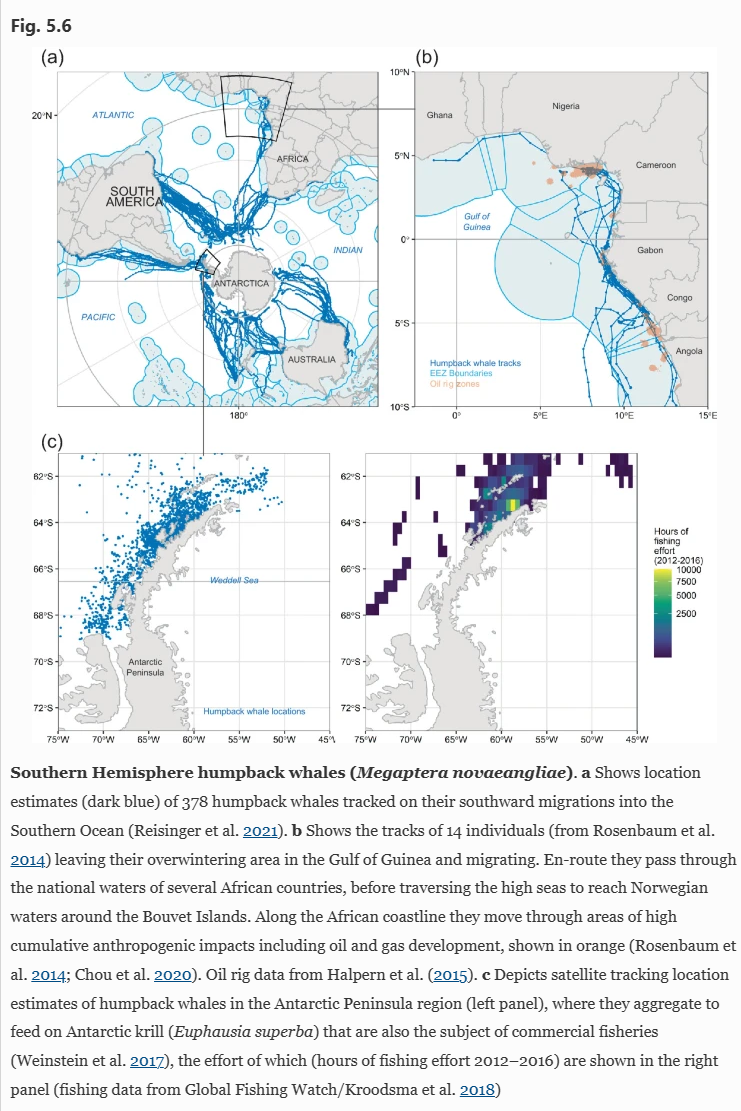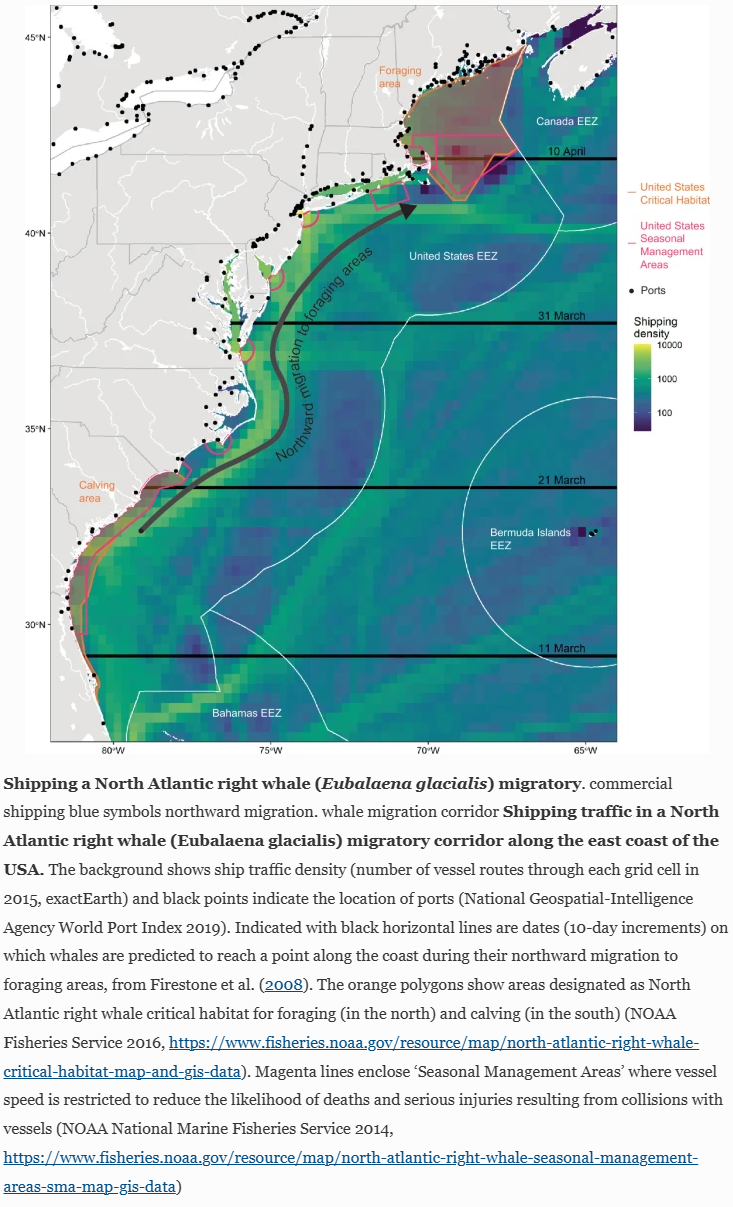Migration
Cf.
- dispersal
- colonisation
- nomadism
- sedentary lifestyles
- movescapes
Cf.
- eco-evolutionary dynamics
- metapopulation ecology
Movement Ecology journal
Definition
Different but overlapping concepts:
- a type of locomotory activity that is notably persistent, undistracted, and straightened out
- a relocation of the animal that is on a much greater scale, and involves movement of much longer duration, than those arising in its normal daily activities
- a seasonal to-and-fro movement of populations between regions where conditions are alternately favourable or unfavourable (including one region in which breeding occurs)
- movements leading to redistribution within a spatially extended population.
The above is from:
Dingle, Hugh, and V. Alistair Drake. ‘What Is Migration?’ BioScience 57, no. 2 (2007): 113–21. https://doi.org/10/bjdj4b.
Types in Ecology
- seasonal
- circadian, following daily cycles of activity and rest, synchronised with light and dark, heat and cold, etc.
- tidal
- diel, change their location or behaviour according to the time of day. For example, some butterflies migrate from shady to sunny areas during the day and back at night
- altitudinal, up and down hills following seasons and weather
- latitudinal, north-south with climate
- longitudinal, east-west with climate, e.g., monarch butterflies migrate from eastern North America to central Mexico during winter and back during spring
- natal, returning to birth place
- nomadic, opportunistic, or example, some wildebeest migrate across the Serengeti plains following the rains and grass growth
- irruptive, in response to sudden population growth and food availability, for example, some lemmings migrate en masse when their population exceeds the carrying capacity of their habitat
In water:
- vertical, up and down the water column, usually in response to changes in light, temperature, food, or predation. For example, some fish migrate vertically to feed at night and avoid predators during the day
- horizontal, across the water surface or along the bottom, usually in response to changes in currents, tides, seasons, or breeding. For example, some jellyfish migrate horizontally to follow the plankton blooms
- anadromous migration, movement of fish that live in salt water and migrate to fresh water to spawn. For example, salmon
- catadromous, movement of fish that live in fresh water and migrate to salt water to spawn. For example, some eels migrate from freshwater lakes to the ocean where they breed and die
- amphidromous, movement of fish that move between fresh and salt water during their life cycle, but not for spawning. For example, some gobies migrate from freshwater streams to estuaries and back
- potamodromous, movement of fish that live and migrate within fresh water only. For example, some sturgeon migrate from lakes to rivers to spawn
- ceanodromous, movement of fish that live and migrate within salt water only. For example, some tuna migrate across oceans following temperature and food gradients
Consider human and nonhuman migrations as one system. In modified environments, it is useful to study human-cultural and eco movements and disruptions together.
Migrations can be emergency events but they are also standard and common.
Shah, Sonia. The Next Great Migration: The Beauty and Terror of Life on the Move. New York: Bloomsbury, 2020.
Ecological Benefits of Migration
Migratory fish, birds, and marine mammals move between oceans, rivers, and land, playing a crucial role in maintaining biodiversity, ecosystem productivity, and habitat resilience. For example, salmon and albatrosses transport nutrients from the ocean to inland ecosystems, enriching soils and supporting food webs. Eels grow in freshwater but migrate to the ocean to breed and die, fertilizing offshore areas and contributing to marine nutrient cycles.

Sandin, Stuart A., Penny A. Becker, Ceiba Becker, et al. 2022. “Harnessing Island–Ocean Connections to Maximize Marine Benefits of Island Conservation.” Proceedings of the National Academy of Sciences 119 (51): e2122354119. https://doi.org/10/g5kjtb.
Current State, Trends, and Needs
The extinction risk for migratory species is increasing.
UNEP-WCMC. 2024. State of the World’s Migratory Species. The UN Environment Programme World Conservation Monitoring Centre, Convention on the Conservation of Migratory Species of Wild Animals.
There is a need for more research on migration, including land-sea connectivity.
Movement Ecology
The short foundational article:
Nathan, Ran. ‘An Emerging Movement Ecology Paradigm’. Proceedings of the National Academy of Sciences 105, no. 49 (2008): 19050–51. https://doi.org/10/dgk2c4.
Demšar, Urška, Kevin Buchin, Francesca Cagnacci, Kamran Safi, Bettina Speckmann, Nico Van de Weghe, Daniel Weiskopf, and Robert Weibel. ‘Analysis and Visualisation of Movement: An Interdisciplinary Review’. Movement Ecology 3, no. 1 (2015): 5. https://doi.org/10/gfw985.
A review of movement ecology framework:
Joo, Rocío, Simona Picardi, Matthew E. Boone, Thomas A. Clay, Samantha C. Patrick, Vilma S. Romero-Romero, and Mathieu Basille. ‘Recent Trends in Movement Ecology of Animals and Human Mobility’. Movement Ecology 10, no. 1 (2022): 26. https://doi.org/10/h6mp.
Tracking devices:
- Accelerometer Any technology that is placed on a subject and measures the acceleration of the tag, thus gathering information on the multidimensional movement of the individual which can be used to infer behavioral modes and energy expenditure.
- Acoustic Any technology that uses sound to infer location, either in a similar way to radio telemetry or in an acoustic array where animal vocalizations are recorded and the location of sensors in the array are used to obtain an animal’s location.
- Body conditions Any technology that uses body condition sensors to collect data on the subject that may be associated with a movement or lack thereof, such as temperature and heart rate.
- Camera Any device that records location/presence via camera; mainly camera traps with known locations where the capture of the individual implies the location.
- Encounter Any analog tracking method where the user must capture and place a marker on a subject (e.g. pit tags, bands). The recapturing/resighting of the subject infers the movement. This category was difficult to resolve in our study due to a lack of specificity in the phrases used in the literature.
- GPS Any technology that uses GPS satellites to calculate the location of an object, which can be handheld GPS devices or animal-borne tags.
- Light loggers Any technology that records light levels and derives locations based on the timing of twilight events.
- Pressure Any technology that records pressure readings to infer vertical movement, such as through a water column.
- Radar Any technology that uses ‘radio detection and ranging’ devices to track objects. It can be large weather arrays or tracking radars.
- Radio telemetry Any technology that infers location based on radio telemetry (VHF/UHF frequency).
- Satellite Any tag that collects location via, and sends data to, satellites (except Global Position System [GPS] satellites), so that data can be accessed remotely. The most frequently used system is ARGOS.
- Video Any device that records movement via video.
McMahon, Kathryn, Kor-jent van Dijk, Leonardo Ruiz-Montoya, Gary A. Kendrick, Siegfried L. Krauss, Michelle Waycott, Jennifer Verduin, et al. ‘The Movement Ecology of Seagrasses’. Proceedings of the Royal Society B: Biological Sciences 281, no. 1795 (2014): 20140878. https://doi.org/10/gstk2n.


Reisinger, Ryan R., Chris Johnson, and Ari S. Friedlaender. ‘Marine Mammal Movement Ecology in a Conservation and Management Context’. In Marine Mammals: The Evolving Human Factor, edited by Giuseppe Notarbartolo di Sciara and Bernd Würsig, 149–92. Cham: Springer, 2022.
Human Migration
Manning, Patrick, and Tiffany Trimmer. Migration in World History. 3rd ed. Themes in World History. 2004. Reprint, London: Routledge, 2020.
More-than-Human Movement Patterns
Notarbartolo di Sciara, Giuseppe, and Bernd Würsig, eds. Marine Mammals: The Evolving Human Factor. Cham: Springer, 2022.
Fahrig, Lenore. ‘Non-Optimal Animal Movement in Human-Altered Landscapes’. Functional Ecology 21, no. 6 (2007): 1003–15. https://doi.org/10/bf2q9x.
Drouineau, Hilaire, Caroline Durif, Martin Castonguay, Maria Mateo, Eric Rochard, Guy Verreault, Kazuki Yokouchi, and Patrick Lambert. ‘Freshwater Eels: A Symbol of the Effects of Global Change’. Fish and Fisheries 19, no. 5 (2018): 903–30. https://doi.org/10/gns2r3.
Databases, Tools, and Organisations
Movebank A free, online database of animal tracking data hosted by the Max Planck Institute of Animal Behavior and the University of Konstanz.
ICARUS: The International Cooperation for Animal Research Using Space is a global collaboration of researchers that use a satellite-based system to track small animals such as birds, bats, and insects.
Movement of Life, at Smithsonian
The Migratory Connectivity Project
References
Dingle, Hugh. Migration: The Biology of Life on the Move. 2nd ed. 1996. Reprint, New York: Oxford University Press, 2014.
Hendry, Andrew P. Eco-Evolutionary Dynamics. Princeton: Princeton University Press, 2018.
Backlinks